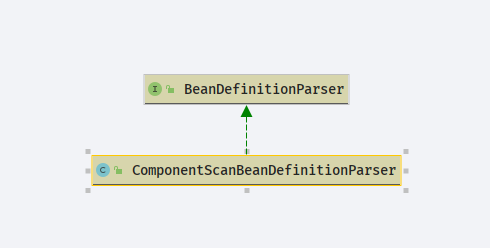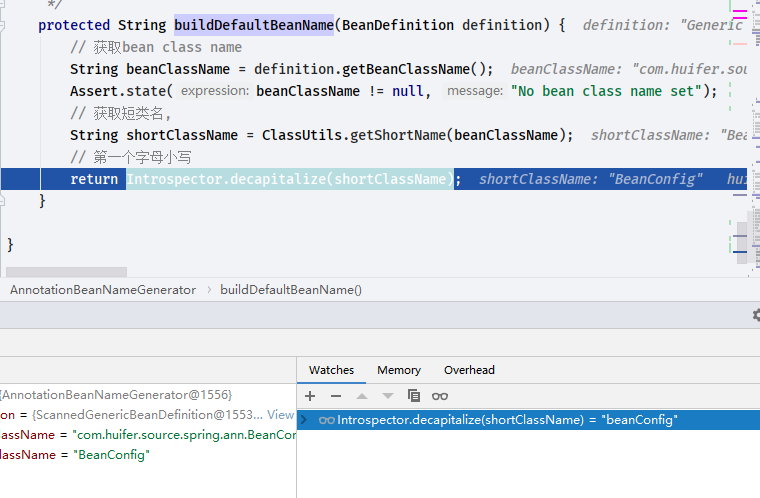Spring scan
解析
- Spring 注解形式使用有下面两种方式
- 通过
AnnotationConfigApplicationContext参数:扫描包 - 通过 xml 配置
context:component-scan属性base-package
AnnotationConfigApplicationContext aac = new AnnotationConfigApplicationContext("com.huifer.source.spring.ann");
<context:component-scan base-package="com.huifer.source.spring.ann"> </context:component-scan>
- 目标明确开始找入口方法
AnnotationConfigApplicationContext直接点进去看就找到了
public AnnotationConfigApplicationContext(String... basePackages) { this(); // 扫描包 scan(basePackages); refresh(); }
context:component-scan寻找方式:冒号:钱+NamespaceHandler 或者全文搜索component-scan,最终找到org.springframework.context.config.ContextNamespaceHandler
public class ContextNamespaceHandler extends NamespaceHandlerSupport { @Override public void init() { registerBeanDefinitionParser("property-placeholder", new PropertyPlaceholderBeanDefinitionParser()); registerBeanDefinitionParser("property-override", new PropertyOverrideBeanDefinitionParser()); registerBeanDefinitionParser("annotation-config", new AnnotationConfigBeanDefinitionParser()); registerBeanDefinitionParser("component-scan", new ComponentScanBeanDefinitionParser()); registerBeanDefinitionParser("load-time-weaver", new LoadTimeWeaverBeanDefinitionParser()); registerBeanDefinitionParser("spring-configured", new SpringConfiguredBeanDefinitionParser()); registerBeanDefinitionParser("mbean-export", new MBeanExportBeanDefinitionParser()); registerBeanDefinitionParser("mbean-server", new MBeanServerBeanDefinitionParser()); }}
org.springframework.context.annotation.ComponentScanBeanDefinitionParser

- 实现
BeanDefinitionParser直接看parse方法
@Override @Nullable public BeanDefinition parse(Element element, ParserContext parserContext) { // 获取 base-package 属性值 String basePackage = element.getAttribute(BASE_PACKAGE_ATTRIBUTE); // 处理 ${} basePackage = parserContext.getReaderContext().getEnvironment().resolvePlaceholders(basePackage); // 分隔符`,;\t\n`切分 String[] basePackages = StringUtils.tokenizeToStringArray(basePackage, ConfigurableApplicationContext.CONFIG_LOCATION_DELIMITERS); // Actually scan for bean definitions and register them. // 扫描对象创建 ClassPathBeanDefinitionScanner scanner = configureScanner(parserContext, element); // 执行扫描方法 Set<BeanDefinitionHolder> beanDefinitions = scanner.doScan(basePackages); // 注册组件,触发监听 registerComponents(parserContext.getReaderContext(), beanDefinitions, element); return null; }
- 回过头看
AnnotationConfigApplicationContext
org.springframework.context.annotation.AnnotationConfigApplicationContext
public AnnotationConfigApplicationContext(String... basePackages) { this(); // 扫描包 scan(basePackages); refresh(); }
private final ClassPathBeanDefinitionScanner scanner; @Override public void scan(String... basePackages) { Assert.notEmpty(basePackages, "At least one base package must be specified"); this.scanner.scan(basePackages); }
org.springframework.context.annotation.ClassPathBeanDefinitionScanner.scan
public int scan(String... basePackages) { // 获取bean数量 int beanCountAtScanStart = this.registry.getBeanDefinitionCount(); // 执行扫描 doScan(basePackages); // Register annotation config processors, if necessary. if (this.includeAnnotationConfig) { AnnotationConfigUtils.registerAnnotationConfigProcessors(this.registry); } return (this.registry.getBeanDefinitionCount() - beanCountAtScanStart); }
- 这个地方
doScan似曾相识,他就是org.springframework.context.annotation.ComponentScanBeanDefinitionParser.parse中的doScan,下一步解析 doScan
org.springframework.context.annotation.ClassPathBeanDefinitionScanner.doScan
protected Set<BeanDefinitionHolder> doScan(String... basePackages) { Assert.notEmpty(basePackages, "At least one base package must be specified"); Set<BeanDefinitionHolder> beanDefinitions = new LinkedHashSet<>(); for (String basePackage : basePackages) { // 寻找组件 Set<BeanDefinition> candidates = findCandidateComponents(basePackage); for (BeanDefinition candidate : candidates) { // bean 作用域设置 ScopeMetadata scopeMetadata = this.scopeMetadataResolver.resolveScopeMetadata(candidate); // 设置生命周期 candidate.setScope(scopeMetadata.getScopeName()); // 创建beanName String beanName = this.beanNameGenerator.generateBeanName(candidate, this.registry); if (candidate instanceof AbstractBeanDefinition) { // 设置默认属性 具体方法:org.springframework.beans.factory.support.AbstractBeanDefinition.applyDefaults postProcessBeanDefinition((AbstractBeanDefinition) candidate, beanName); } if (candidate instanceof AnnotatedBeanDefinition) { // 读取Lazy,Primary 等注解 AnnotationConfigUtils.processCommonDefinitionAnnotations((AnnotatedBeanDefinition) candidate); } // bean的重复检查 if (checkCandidate(beanName, candidate)) { // 创建 BeanDefinitionHolder BeanDefinitionHolder definitionHolder = new BeanDefinitionHolder(candidate, beanName); // 代理对象的处理 definitionHolder = AnnotationConfigUtils.applyScopedProxyMode(scopeMetadata, definitionHolder, this.registry); // 放入list中,最后返回用 beanDefinitions.add(definitionHolder); // 注册bean registerBeanDefinition(definitionHolder, this.registry); } } } return beanDefinitions; }
org.springframework.context.annotation.ClassPathScanningCandidateComponentProvider#findCandidateComponents
public Set<BeanDefinition> findCandidateComponents(String basePackage) { // 扫描 if (this.componentsIndex != null && indexSupportsIncludeFilters()) { return addCandidateComponentsFromIndex(this.componentsIndex, basePackage); } else { return scanCandidateComponents(basePackage); } }
/** * 扫描当前包路径下的资源 * @param basePackage * @return */ private Set<BeanDefinition> scanCandidateComponents(String basePackage) { Set<BeanDefinition> candidates = new LinkedHashSet<>(); try { // 字符串拼接出一个编译后的路径 classpath:// // 这里替换了通配符 String packageSearchPath = ResourcePatternResolver.CLASSPATH_ALL_URL_PREFIX + resolveBasePackage(basePackage) + '/' + this.resourcePattern; // 获取资源 Resource[] resources = getResourcePatternResolver().getResources(packageSearchPath); // 日志级别 boolean traceEnabled = logger.isTraceEnabled(); boolean debugEnabled = logger.isDebugEnabled(); for (Resource resource : resources) { if (traceEnabled) { logger.trace("Scanning " + resource); } if (resource.isReadable()) { try { // 获取 MetadataReader MetadataReader metadataReader = getMetadataReaderFactory().getMetadataReader(resource); // 判断是否是 Component if (isCandidateComponent(metadataReader)) { ScannedGenericBeanDefinition sbd = new ScannedGenericBeanDefinition(metadataReader); sbd.setResource(resource); sbd.setSource(resource); if (isCandidateComponent(sbd)) { if (debugEnabled) { logger.debug("Identified candidate component class: " + resource); } candidates.add(sbd); } else { if (debugEnabled) { logger.debug("Ignored because not a concrete top-level class: " + resource); } } } else { if (traceEnabled) { logger.trace("Ignored because not matching any filter: " + resource); } } } catch (Throwable ex) { throw new BeanDefinitionStoreException( "Failed to read candidate component class: " + resource, ex); } } else { if (traceEnabled) { logger.trace("Ignored because not readable: " + resource); } } } } catch (IOException ex) { throw new BeanDefinitionStoreException("I/O failure during classpath scanning", ex); } return candidates; }
org.springframework.context.annotation.ScopeMetadataResolver#resolveScopeMetadata
/** * 生命周期设置 * * @param definition the target bean definition * @return */ @Override public ScopeMetadata resolveScopeMetadata(BeanDefinition definition) { ScopeMetadata metadata = new ScopeMetadata(); // 判断是否属于 AnnotatedBeanDefinition if (definition instanceof AnnotatedBeanDefinition) { AnnotatedBeanDefinition annDef = (AnnotatedBeanDefinition) definition; AnnotationAttributes attributes = AnnotationConfigUtils.attributesFor( annDef.getMetadata(), this.scopeAnnotationType); if (attributes != null) { // 获取 value 属性值并且设置 metadata.setScopeName(attributes.getString("value")); // 获取 proxyMode 属性值并且设置 ScopedProxyMode proxyMode = attributes.getEnum("proxyMode"); if (proxyMode == ScopedProxyMode.DEFAULT) { proxyMode = this.defaultProxyMode; } metadata.setScopedProxyMode(proxyMode); } } return metadata; }
org.springframework.context.annotation.AnnotationScopeMetadataResolverTests#resolveScopeMetadataShouldReadScopedProxyModeFromAnnotation测试用例
@Test public void resolveScopeMetadataShouldReadScopedProxyModeFromAnnotation() { AnnotatedBeanDefinition bd = new AnnotatedGenericBeanDefinition(AnnotatedWithScopedProxy.class); ScopeMetadata scopeMetadata = this.scopeMetadataResolver.resolveScopeMetadata(bd); assertNotNull("resolveScopeMetadata(..) must *never* return null.", scopeMetadata); assertEquals("request", scopeMetadata.getScopeName()); assertEquals(TARGET_CLASS, scopeMetadata.getScopedProxyMode()); }

org.springframework.beans.factory.support.BeanNameGenerator#generateBeanName
- 创建 beanName
org.springframework.context.annotation.AnnotationBeanNameGenerator#generateBeanName
@Override public String generateBeanName(BeanDefinition definition, BeanDefinitionRegistry registry) { if (definition instanceof AnnotatedBeanDefinition) { // 如果存在bean(value="") value存在 String beanName = determineBeanNameFromAnnotation((AnnotatedBeanDefinition) definition); if (StringUtils.hasText(beanName)) { // Explicit bean name found. return beanName; } } // Fallback: generate a unique default bean name. // 创建beanName return buildDefaultBeanName(definition, registry); }
@Nullable protected String determineBeanNameFromAnnotation(AnnotatedBeanDefinition annotatedDef) { AnnotationMetadata amd = annotatedDef.getMetadata(); Set<String> types = amd.getAnnotationTypes(); String beanName = null; for (String type : types) { AnnotationAttributes attributes = AnnotationConfigUtils.attributesFor(amd, type); if (attributes != null && isStereotypeWithNameValue(type, amd.getMetaAnnotationTypes(type), attributes)) { // 获取注解的value 属性值 Object value = attributes.get("value"); if (value instanceof String) { String strVal = (String) value; // 判断是否存在值 if (StringUtils.hasLength(strVal)) { if (beanName != null && !strVal.equals(beanName)) { throw new IllegalStateException("Stereotype annotations suggest inconsistent " + "component names: '" + beanName + "' versus '" + strVal + "'"); } // beanName = value属性值 beanName = strVal; } } } } return beanName; }
@Service(value = "dhc")public class DemoService {}

org.springframework.context.annotation.AnnotationBeanNameGenerator#buildDefaultBeanName(org.springframework.beans.factory.config.BeanDefinition, org.springframework.beans.factory.support.BeanDefinitionRegistry)
org.springframework.context.annotation.AnnotationBeanNameGenerator#buildDefaultBeanName(org.springframework.beans.factory.config.BeanDefinition)
protected String buildDefaultBeanName(BeanDefinition definition) { // 获取bean class name String beanClassName = definition.getBeanClassName(); Assert.state(beanClassName != null, "No bean class name set"); // 获取短类名, String shortClassName = ClassUtils.getShortName(beanClassName); // 第一个字母小写 return Introspector.decapitalize(shortClassName); }
@Configurationpublic class BeanConfig { @Scope(value =ConfigurableBeanFactory.SCOPE_PROTOTYPE) @Bean(value = "hc") public Ubean f() { return new Ubean(); }}

org.springframework.context.annotation.ClassPathBeanDefinitionScanner#postProcessBeanDefinition
protected void postProcessBeanDefinition(AbstractBeanDefinition beanDefinition, String beanName) { beanDefinition.applyDefaults(this.beanDefinitionDefaults); if (this.autowireCandidatePatterns != null) { beanDefinition.setAutowireCandidate(PatternMatchUtils.simpleMatch(this.autowireCandidatePatterns, beanName)); } }
public void applyDefaults(BeanDefinitionDefaults defaults) { setLazyInit(defaults.isLazyInit()); setAutowireMode(defaults.getAutowireMode()); setDependencyCheck(defaults.getDependencyCheck()); setInitMethodName(defaults.getInitMethodName()); setEnforceInitMethod(false); setDestroyMethodName(defaults.getDestroyMethodName()); setEnforceDestroyMethod(false); }
org.springframework.context.annotation.AnnotationConfigUtils#processCommonDefinitionAnnotations(org.springframework.beans.factory.annotation.AnnotatedBeanDefinition)
public static void processCommonDefinitionAnnotations(AnnotatedBeanDefinition abd) { processCommonDefinitionAnnotations(abd, abd.getMetadata()); }
static void processCommonDefinitionAnnotations(AnnotatedBeanDefinition abd, AnnotatedTypeMetadata metadata) { // 获取 lazy 注解 AnnotationAttributes lazy = attributesFor(metadata, Lazy.class); if (lazy != null) { abd.setLazyInit(lazy.getBoolean("value")); } else if (abd.getMetadata() != metadata) { lazy = attributesFor(abd.getMetadata(), Lazy.class); if (lazy != null) { abd.setLazyInit(lazy.getBoolean("value")); } } if (metadata.isAnnotated(Primary.class.getName())) { abd.setPrimary(true); } AnnotationAttributes dependsOn = attributesFor(metadata, DependsOn.class); if (dependsOn != null) { abd.setDependsOn(dependsOn.getStringArray("value")); } AnnotationAttributes role = attributesFor(metadata, Role.class); if (role != null) { abd.setRole(role.getNumber("value").intValue()); } AnnotationAttributes description = attributesFor(metadata, Description.class); if (description != null) { abd.setDescription(description.getString("value")); } }
org.springframework.context.annotation.ClassPathBeanDefinitionScanner#checkCandidate
protected boolean checkCandidate(String beanName, BeanDefinition beanDefinition) throws IllegalStateException { // 判断当前 beanName 是否在注册表中 if (!this.registry.containsBeanDefinition(beanName)) { return true; } // 从注册表中获取 BeanDefinition existingDef = this.registry.getBeanDefinition(beanName); // 当前的bean BeanDefinition originatingDef = existingDef.getOriginatingBeanDefinition(); if (originatingDef != null) { existingDef = originatingDef; } if (isCompatible(beanDefinition, existingDef)) { return false; } throw new ConflictingBeanDefinitionException("Annotation-specified bean name '" + beanName + "' for bean class [" + beanDefinition.getBeanClassName() + "] conflicts with existing, " + "non-compatible bean definition of same name and class [" + existingDef.getBeanClassName() + "]"); }
org.springframework.context.annotation.AnnotationConfigUtils#applyScopedProxyMode
static BeanDefinitionHolder applyScopedProxyMode( ScopeMetadata metadata, BeanDefinitionHolder definition, BeanDefinitionRegistry registry) { ScopedProxyMode scopedProxyMode = metadata.getScopedProxyMode(); if (scopedProxyMode.equals(ScopedProxyMode.NO)) { return definition; } boolean proxyTargetClass = scopedProxyMode.equals(ScopedProxyMode.TARGET_CLASS); // 创建代理对象 return ScopedProxyCreator.createScopedProxy(definition, registry, proxyTargetClass); }





